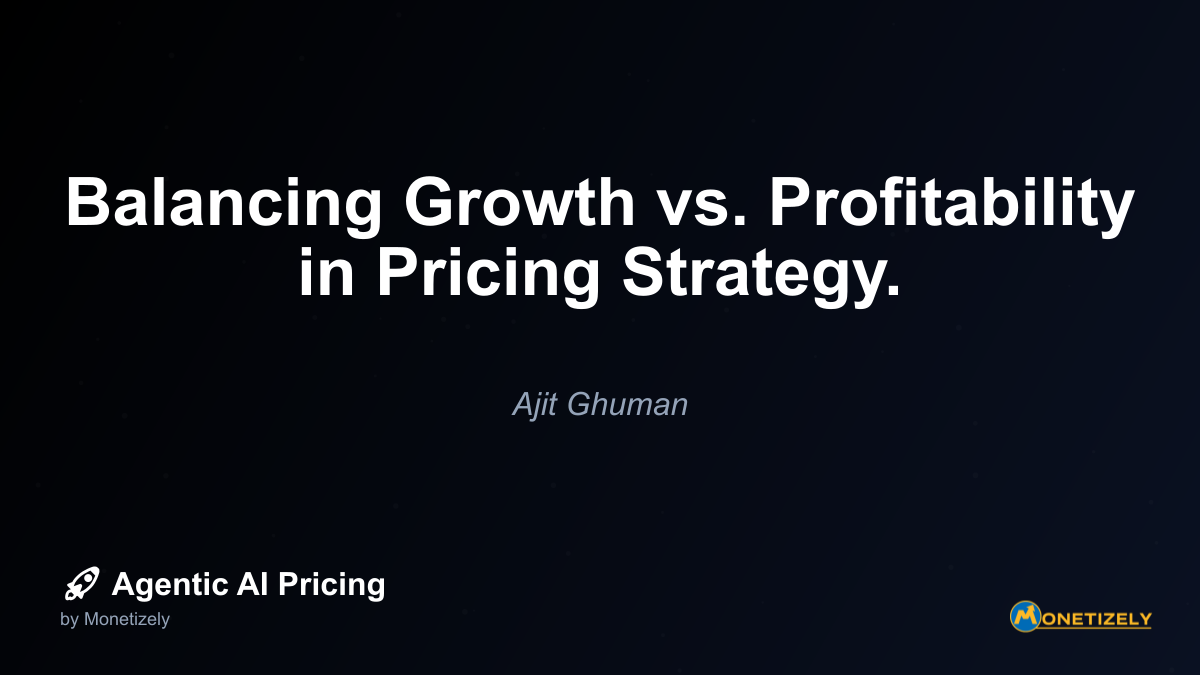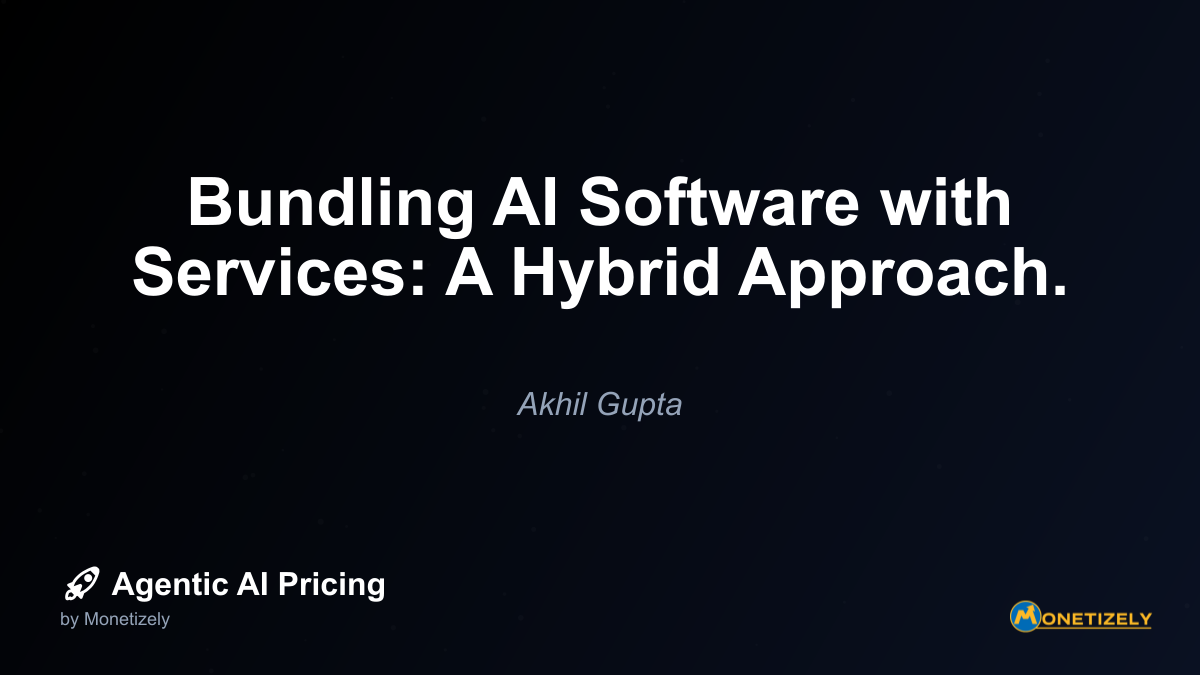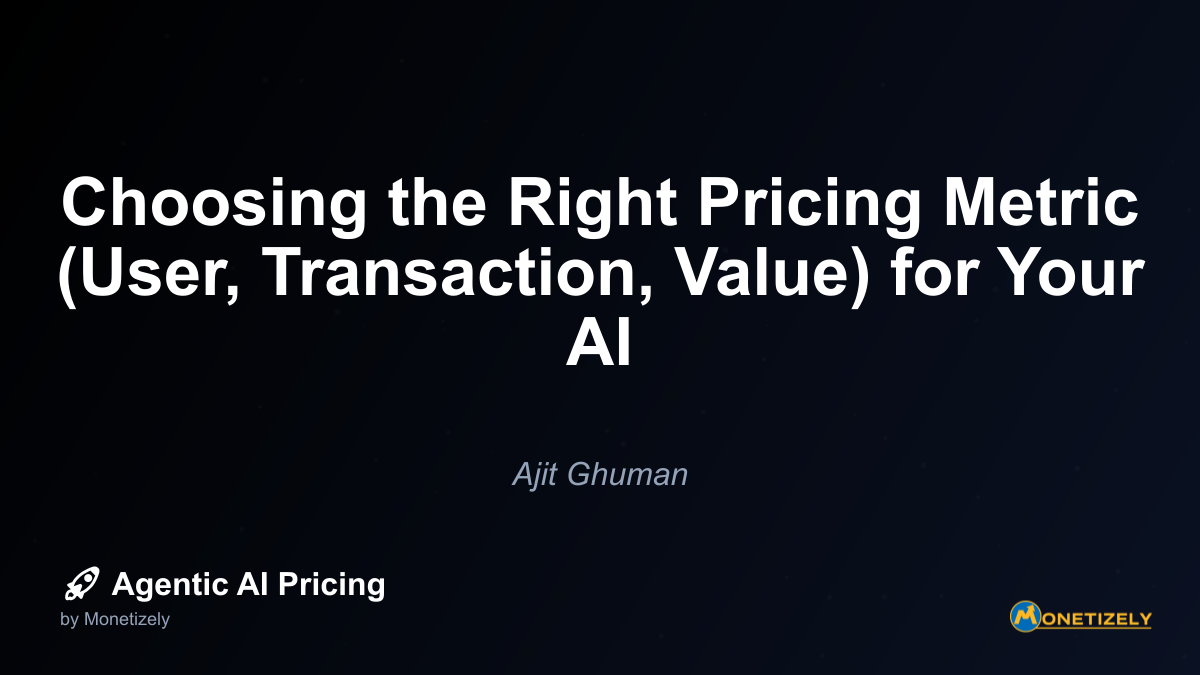· Akhil Gupta · Strategy & Planning · 10 min read
FAQ: Common Questions About Agentic AI Pricing Answered.
AI and SaaS Pricing Masterclass
Learn the art of strategic pricing directly from industry experts. Our comprehensive course provides frameworks and methodologies for optimizing your pricing strategy in the evolving AI landscape. Earn a professional certification that can be imported directly to your LinkedIn profile.

The most effective approach is often to start with a simpler model that customers can easily understand, then evolve toward more sophisticated value-based pricing as the market matures. For a deeper exploration of subscription versus usage-based models specifically for AI solutions, check out our detailed comparison at Subscription vs. Usage-Based AI Pricing: Which Model Is Right for Your Business?
How should we handle pricing for agentic AI that improves over time?
This question addresses the unique characteristic of AI systems that become more valuable through ongoing learning and improvement. Several approaches can help capture this increasing value:
1. Value-escalation clauses
Include contractual provisions that allow for price adjustments as performance metrics improve beyond established baselines. For example, if the AI reduces processing time by an additional 15% through learning, pricing can adjust accordingly.
2. Performance-linked tiers
Structure pricing tiers based on performance metrics rather than features, allowing customers to automatically move to higher tiers as the system improves. This creates a natural progression that aligns with increasing value.
3. Renewal optimization
Maintain initial contract pricing but adjust at renewal based on documented performance improvements and value delivered. This approach gives customers predictability while allowing you to capture increased value over time.
4. Innovation credits
Offer credits for early adopters who help train and improve the system, acknowledging their contribution to the AI’s development. These credits can offset future price increases as the system matures.
5. Capability expansion
Rather than increasing prices for existing capabilities, introduce new premium capabilities enabled by improved AI performance. This expands your monetization options without disrupting existing customer relationships.
The key principle is transparency about how and why pricing may evolve. Customers are generally receptive to paying more for increased value if they understand the relationship between performance improvements and pricing adjustments.
What metrics should we track to ensure our agentic AI pricing is effective?
Effective pricing requires monitoring both financial and operational metrics to ensure alignment between value delivery and revenue capture:
1. Customer-centric metrics
- Customer Lifetime Value (CLV) to Customer Acquisition Cost (CAC) ratio
- Expansion revenue percentage (additional spending from existing customers)
- Feature/capability adoption rates across pricing tiers
- Churn rate segmented by pricing tier and usage patterns
- Net Promoter Score (NPS) correlated with pricing tiers
2. Performance-based metrics
- Task completion rates and success percentages
- Error rates and resolution timelines
- Processing time improvements over baseline
- Resource utilization efficiency
- Learning curve indicators (improvement rate over time)
3. Financial health metrics
- Gross margin by customer segment
- Average revenue per user (ARPU) trends
- Discounting frequency and magnitude
- Conversion rates between pricing tiers
- Revenue predictability (variance from forecasts)
4. Competitive positioning metrics
- Win/loss rates against specific competitors
- Price sensitivity during sales negotiations
- Feature comparison vs. price point analysis
- Market share trends by customer segment
- Pricing perception in customer surveys
Regular analysis of these metrics enables data-driven pricing adjustments that maximize both customer value and business sustainability. The most successful organizations review these metrics quarterly and make incremental pricing refinements rather than dramatic changes.
How do we communicate agentic AI pricing to customers who are new to the technology?
Effectively communicating pricing for novel technologies requires education alongside traditional sales approaches:
1. Value translation
Translate technical capabilities into business outcomes using language familiar to the customer’s industry. For example, rather than explaining how the AI works, focus on how it reduces processing time or improves decision quality.
2. Comparative frameworks
Create side-by-side comparisons between current processes and AI-enabled workflows, highlighting efficiency gains, cost savings, and quality improvements. This bridges the conceptual gap between familiar operations and new approaches.
3. Tiered adoption paths
Offer graduated implementation options that allow customers to start with lower-risk applications before expanding to more critical processes. This builds confidence while demonstrating value incrementally.
4. ROI calculators
Develop interactive tools that allow prospects to input their specific variables (labor costs, transaction volumes, error rates) and see projected returns from implementing your solution. This transforms abstract benefits into concrete financial projections.
5. Case studies with similar organizations
Showcase detailed examples of similar organizations that have successfully implemented your solution, including specific metrics and outcomes. This provides social proof and reduces perceived risk.
6. Free pilots with clear success criteria
Offer limited-scope pilots with pre-defined success metrics, allowing customers to experience value directly before committing to larger investments. This transforms the sales process from theoretical to experiential.
The most effective communication approaches combine education about agentic AI capabilities with clear demonstrations of business value in terms that resonate with the customer’s specific challenges and objectives.
What if our customers want to pay only for successful outcomes?
Pure outcome-based pricing presents both opportunities and challenges for agentic AI providers:
1. Define “success” precisely
Create unambiguous definitions of successful outcomes with measurable criteria. This prevents disputes and ensures mutual understanding of what constitutes a billable success.
2. Implement partial outcome-based models
Consider hybrid models with a base subscription plus outcome-based components. For example, charge a foundational fee that covers costs plus performance bonuses for exceeding target metrics.
3. Establish minimum volume commitments
For customers insisting on pure outcome-based pricing, establish minimum transaction or usage volumes to ensure sufficient scale for profitability. This protects against customers who might deploy the solution too narrowly.
4. Build in complexity factors
Create pricing modifiers for varying task complexity. For instance, standard tasks might have one price point while complex tasks with multiple dependencies could command premium pricing.
5. Include shared risk provisions
Develop contractual safeguards against factors outside your control that might impact success rates. For example, if the customer’s data quality affects outcomes, include provisions addressing this dependency.
6. Implement graduated pricing tiers
Structure pricing so that initial successes cost more than subsequent ones, recognizing the higher value of early wins and the efficiency of scale. This creates natural price optimization as usage increases.
While outcome-based pricing can align incentives powerfully, it requires sophisticated tracking systems and clear contractual terms. For many providers, a gradual transition from traditional models toward outcome components offers the best balance of innovation and sustainability.
How do we price agentic AI when it’s integrated with existing systems?
Integration scenarios present unique pricing considerations that reflect the combined value of your AI with existing infrastructure:
1. Value-add pricing
Position pricing as an increment above the customer’s existing investment, highlighting the enhanced value of current systems when augmented by your AI. This frames the decision as an optimization rather than a replacement.
2. Integration complexity tiers
Structure pricing tiers based on the complexity of integration required. Simple API connections might fall into base tiers, while deep integrations with legacy systems command premium pricing.
3. Data volume considerations
For integrations where the AI processes data from existing systems, incorporate data volume or complexity factors into pricing. This recognizes that value often correlates with the scope of data the AI can leverage.
4. Joint ROI calculations
Develop ROI models that show the combined return from the integrated solution rather than isolating your component. This demonstrates how your AI amplifies the value of existing investments.
5. Partner ecosystem pricing
For common integration targets, develop standardized pricing and implementation approaches with technology partners. This simplifies the customer decision process while creating go-to-market advantages.
6. Migration incentives
Offer pricing incentives that recognize and offset switching costs when customers transition from manual processes or competing solutions. This acknowledges the total cost of change beyond your license fees.
The most successful integration pricing strategies recognize that value emerges from the combined solution rather than individual components. This perspective supports premium pricing for the transformative impact of properly integrated agentic AI.
What is the best way to handle pricing for multi-agent systems with varying capabilities?
Multi-agent systems present unique pricing challenges due to their complexity and diverse capabilities:
1. Agent ensemble pricing
Create bundled pricing for collections of complementary agents, offering discounts compared to individual agent pricing. This encourages adoption of complete solutions while simplifying purchasing decisions.
2. Core + extension model
Establish base pricing for fundamental agents with add-on pricing for specialized capabilities. This allows customers to customize their implementation while maintaining pricing clarity.
3. Capability-based tiers
Structure pricing tiers based on the sophistication of tasks agents can perform rather than the number of agents. This focuses on value delivery rather than technical implementation details.
4. Orchestration premiums
Include premium pricing for orchestration capabilities that coordinate multiple agents, recognizing the additional value of seamless collaboration between specialized AI systems.
5. Domain-specific packaging
Create industry or function-specific agent packages with pricing optimized for particular use cases. This simplifies decision-making while positioning your offering as tailored to specific business needs.
6. Usage allocation flexibility
Offer pricing that allows customers to shift usage between different agents within overall limits. This provides flexibility while maintaining predictable costs.
For a deeper exploration of pricing considerations specific to multi-agent systems, our detailed analysis at Single-Agent vs Multi-Agent Systems: How Should You Price Your AI Solution? provides additional guidance.
How do we compete with free or low-cost agentic AI alternatives?
As with many software categories, agentic AI markets include both premium and low-cost options. Differentiating from cheaper alternatives requires a clear value narrative:
1. Total value of ownership analysis
Create comprehensive comparisons that look beyond license costs to include implementation, integration, training, and ongoing management. This often reveals that “free” alternatives carry significant hidden costs.
2. Performance differentiation
Document and demonstrate measurable performance advantages in accuracy, speed, or capabilities that directly impact business outcomes. Quantify the value of these advantages in financial terms.
3. Enterprise readiness emphasis
Highlight enterprise-grade features absent from low-cost alternatives: security certifications, compliance capabilities, SLAs, and dedicated support. Position these as essential rather than optional for business-critical applications.
4. Ecosystem advantages
Showcase integration capabilities, partner networks, and implementation resources that accelerate time-to-value compared to alternatives that may require more custom development.
5. Roadmap differentiation
Communicate your innovation pipeline and development resources, contrasting with the uncertain future of free or venture-funded alternatives that may lack sustainable business models.
6. Risk mitigation narrative
Frame pricing premiums as insurance against the risks of deploying less robust solutions for business-critical functions. This shifts the conversation from cost to risk management.
The key is avoiding feature-by-feature comparisons that commoditize your offering. Instead, focus on the complete solution experience and long-term partnership value that justifies premium positioning.
How should we adjust our pricing as agentic AI technology matures?
The rapidly evolving nature of agentic AI requires thoughtful approaches to pricing evolution:
1. Value-based adjustment triggers
Establish clear metrics that will trigger pricing revisions, such as performance improvements, cost structure changes, or market developments. This creates predictability around how and why pricing might change.
2. Grandfathering strategies
Consider protecting existing customers with price guarantees or discount structures when introducing new pricing. This rewards early adopters while allowing pricing to evolve for new customers.
3. Capability expansion approach
Rather than raising prices for existing capabilities, introduce new premium features enabled by technological advances. This expands your monetization options without disrupting existing relationships.
4. Tiered maturity pricing
Create pricing tiers based on the maturity level of different capabilities, with emerging features priced differently than established ones. This allows customers to choose their position on the innovation adoption curve.
5. Transparent communication timelines
Establish predictable cycles for pricing reviews and potential adjustments, communicating these clearly to customers. This reduces uncertainty while allowing for necessary evolution.
6. Market-based recalibration
Regularly benchmark your pricing against both direct competitors and adjacent technologies to ensure alignment with market expectations as the category matures.
The most successful long-term pricing strategies balance the need to capture increasing value with the importance of customer trust and predictability. This typically means incremental evolution rather than dramatic restructuring.
Conclusion
Pricing for agentic AI solutions presents unique challenges that require thoughtful approaches beyond traditional software pricing models. As autonomous AI systems become more prevalent across industries, organizations must develop pricing strategies that accurately reflect the value these systems deliver while addressing legitimate customer concerns about predictability, accountability, and ROI.
The questions addressed in this FAQ represent the most common concerns we encounter when helping organizations develop or optimize their agentic AI pricing strategies. While each situation requires customized approaches based on specific market conditions and solution characteristics, the principles outlined here provide a starting framework for developing effective pricing.
As the agentic AI landscape continues to evolve, pricing strategies will likewise mature. Organizations that maintain a flexible, value-oriented approach—while addressing customer concerns transparently—will be best positioned to capture the full potential of this transformative technology.
For organizations seeking more personalized guidance on agentic AI pricing strategy, AgenticAIPricing.com offers comprehensive consulting services, workshops, and implementation support to help you develop pricing approaches optimized for your specific market and solution.
Co-Founder & COO
Akhil is an Engineering leader with over 16+ years of experience in building, managing and scaling web-scale, high throughput enterprise applications and teams. He has worked with and led technology teams at FabAlley, BuildSupply and Healthians. He is a graduate from Delhi College of Engineering and UC Berkeley certified CTO.
Pricing Strategy Audit
Let our experts analyze your current pricing strategy and identify opportunities for improvement. Our data-driven assessment will help you unlock untapped revenue potential and optimize your AI pricing approach.




